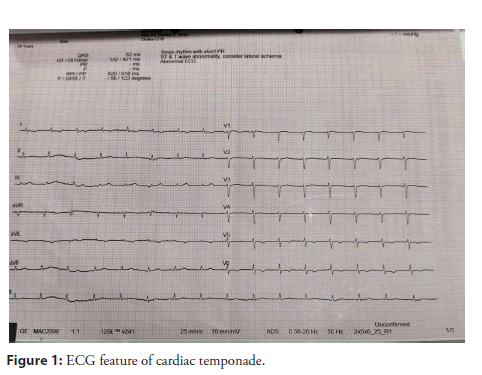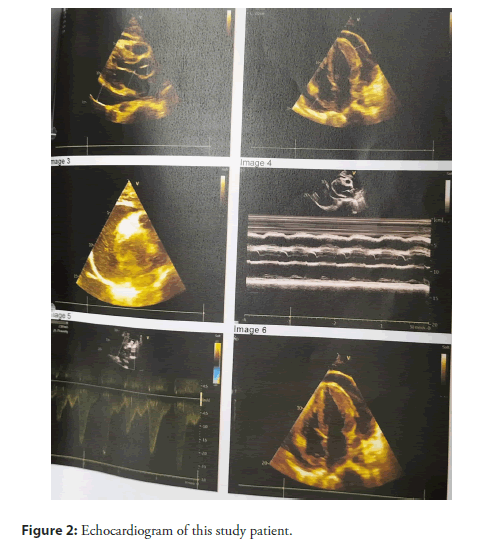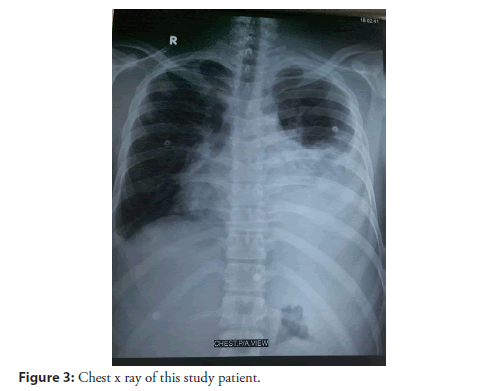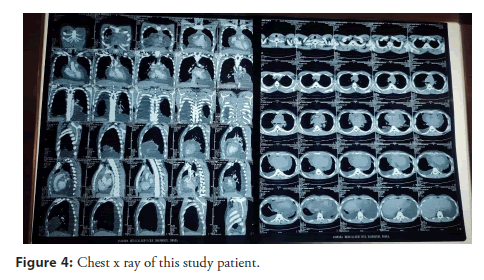Case Report - Interventional Cardiology (2024) Volume 16, Issue 1
Case report on non-Hodgkin lymphoma: Initial presentation as cardiac temponade
- Corresponding Author:
- Ayesha Siddika
Department of cardiology, National Heart Foundation Hospital and Research Institue, Dhaka, Bangladesh,
E-mail: ayeshasiddika835@gmail.com
Received date: 26-Feb-2024, Manuscript No. FMIC-24-128197; Accepted date: 28-Feb-2024, PreQC No. FMIC-24-128197 (PQ); Published date: 13-Mar-2024, QC No. FMIC-24-128197; Revised date: 20-Mar-2024, Manuscript No. FMIC-24-128197 (R); Published date: 27-Mar-2024, ![]()
Abstract
A complicated set of lymphoreticular system cancers are collectively referred to as lymphomas. First developing in the lymphatic tissues, these cancers can move to other lymph node groups and affect the bone marrow before developing into an extranodular mass (NHL) or a non-tender mass or masses in a lymph node region (HL). The prevalence of lymphoid neoplasms, such as Non-Hodgkin’s Lymphoma (NHLs), has been rising for the past thirty years. The prognosis, response to different treatments, and presentation style of NHL vary. NHL usually involves not only lymph nodes but also extranodal sites. Careful evaluation of patient and proper investigations is required for correct diagnosis so that patient will receive the treatment in early stage which has a good prognosis. Here, we are presenting the case of intermediate grade- B-cell NHL of a 26-year-young man.
Keywords
Bacterial nanocellulose; Aortic tube; Vessel grafts; Cardiac surgery; Reconstruction of the aorta; Porcine model
Introduction
Lymphomas typically appear as swollen, non-tender lymph nodes, but they can also affect extranodal areas, such as the head and neck and gastrointestinal system. Compared to NHL, HL has far less instances of extranodal involvement [1,2]. Our knowledge of the biology behind these illnesses has greatly expanded as a result of recent developments in molecular genetics. Particularly since the advent of gene expression profiling, new carcinogenic pathways implicated in the malignant transformation process have been found [3]. Three main kinds of lymphoid malignancies are recognised by the WHO’s version of the Revised European–American Lymphoma Classification: B-cell lymphoma, T-cell/NK cell lymphoma, and Hodgkin’s lymphoma. One of the potential cancers in the head and neck area is NHL, and this is the second most prevalent extranodal NHL site after the gastrointestinal tract. Waldeyer’s ring is the most frequent location of origin in the head and neck, and it may also involve cervical nodes. Other organs that may be impacted in decreasing order of frequency include the salivary glands, orbits, paranasal sinus, nose, and rarely, the regional lymph nodes [4].
Case Presentation
A 26-year young boy nondiabetic, previously normotensive, unmarried presented to our emergency department with the complaints of chest discomfort and shortness of breath for last 15 days. Just on arrival at emergency department clinical examination done shortly and found patient haemodynamically unstable evidenced by nonrecordable blood pressure, severely dyspnoeic, tachycardia, raised JVP and muffuled heart sound. ECG was done immediately revealed low voltage ECG with electrical alternance shown in Figure 1.
Immediately echocardiogram was done shown in Figure 2, and patient shifted to cathlab and pericardiocentesis was done about 600 ml straw colour fluid and shifted to CCU. Now patient quiet stable proper history was taken and physical examination were done. He gave the history of chronic cough with occasional haemoptysis for last 1.5 month, drug abuse e.g. Gaza intake but no history of weight loss, irregular fever, night sweat, any swelling in the body. He recently visited Saudi Arabia and contact with TB patient just few days. After thorough clinical examination found there were absence of lymphadenopathy, hepatomegaly or splenomegaly and ascites.
While all of the investigations on our end and the haematological parameters were being completed, the following results were obtained: HB%: 15.2 gm/dl; WBC: 7,400/cumm; polymorph: 75%; lymphocyte: 20%; ESR: 40 mm in the first hour; RBS: 6.8 mmol/l; S. Creatinine: 1.1 mg/dl; S. Electrolyte: 140.7/3.87/103.5 mmol/l; SGPT-30 U/L; CRP: 46.5 mg/l; ANA and Anti-ds DNA inside normal limits HIV 1 and 2 and HCV negative, TSH-1.56 micro IU/ml, S. albumin-3.8 gm/l, NT-proBNP-1582 pg/ml, and HBsAg-negative. The sputum R/E and AFB, Gene X-pert, are currently shown as nonproductive.
Pericardial fluid analysis revealed that colour-straw, appearance- hazy, and exudative in nature, WBC-40, 000/ cumm, RBC- 17,600/cumm, Neutrophils-00%, Lymphocyte-100%, ADA- 27.60 U/L, no malignant cell.
A clinical board was done and patient discharge on anti-tubercular therapy (category 1) and prednisolone.
But just after 15 days’ patient again presented with feature of cardiac temponade and bilateral pleural effusion left>Right shown in Figure 3. Again pericardiocentesis done about 600 ml straw colour fluid drawn and also 1.5 L straw colour pleural fluid was aspirated. Physical examination again done revealed bilateral few small cervical lymphadenopathy.
At that time CT Scan of chest was done revealed ovoid soft tissue lesion at right lower lung field; possibly granuloma. Rest of the lungs are consistent with pulmonary inflammation along with ground glass opacities at bilateral middle and right lung fields. Enlarged mediastinal and hilar lymphnode shown in Figure 4. Pleural biopsy was done revealed B cell non Hodgkin lymphoma, intermediate grade. Now patient improved better by receiving chemotherapy under haematooncologist.
Discussion
Cancers known as lymphomas originate from the lymphoid system, a sophisticated network of cells and channels that is a fundamental component of the immune system and runs throughout the entire body. An individual lymph node, a cluster of lymph nodes, organs like the stomach and intestine, the sinuses, the bone, the skin, or any combination of these locations may experience them. It is anticipated that the United States will see 63,190 new cases of non-Hodgkin’s lymphoma year 2007. In patients between the ages of fifteen and thirty-four, non-Hodgkin’s lymphomas rank second in terms of cancer-related deaths, and in patients between the ages of thirty-five and fifty-four, they rank third [4].
Lymphoma accounts for 3% of all malignant tumours and is the third most frequent cancer in the world. Lymphomas account for 12% of all malignant tumours of the head and neck area, making them the third most common type of cancer after thyroid carcinoma (33%) and squamous cell carcinoma (46%) [5,6].
A Study done by Siddika et al. clinicopathological pattern of solid malignant tumor in Bangladesh and they showed that about 10% of solid malignant tumour among adult were lymphoma. So it is not uncommon in our country Bangladesh. Additionally, they demonstrated that the majority of lymphoma patients (57.14%) had a mean age of 42.5 years (SD ± 8.77). It was shown that generalised lymphadenopathy accounted for 71.43% of lymphoma cases. Furthermore, cervical lymphadenopathy was present in 21.43% of lymphoma patients. 71.43% of cases were non- Hodgkin’s lymphoma, which was the most prevalent histological type [7].
But our patient only age 26 year and presented with initially cardiac temponade as a rare presentation. Then subsequently presented with cervical lymphadenopathy and bilateral pleural effusion.
As lymphoma is a disease of the lymphoid organs so it can occur in any part of the body. Kusminsky, et al. found that the most common presentations of lymphoma were generalized lymphadenopathy, cervical lymphadenopathy, hepatosplenomegaly, anemia, fever, and weight loss [8].
But unfortunately our patient having no h/o weight loss, anaemia, fever. Bilateral pleural effusion and pericardial effusion also a feature of non-Hodgkin lymphoma along with other clinical presentation. But only pericardial temponade is a rarest presentation. Rather in our country perspective disseminated TB or tubercular pericardial effusion is a common diagnosis that’s why initially we started anti TB along with steroid.
Conclusion
So a young patient with pericardial effusion or pericardial temponade only may be feature of non-Hodgkin lymphoma at initial presentation. Though in our country perspective if associated with clinical feature suggest still tubercular pericardial effusion or disseminated TB in our mind first based on our socioeconomic profile. Thorough clinical examination and extensive investigation must be required. To obtain additional information, a comprehensive community-based study should be conducted. Raising social awareness about primary and secondary prevention, as well as early detection and treatment, is essential to lowering the morbidity, mortality, and overall burden of cancer.
References
- Epstein JB, Epstein JD, Le ND, et al. Characteristics of oral and paraoral malignant lymphoma: A population-based review of 361 cases. Oral Surg Oral Med Oral Pathol Oral Radiol Endod. 92: 519-525 (2001).
- Sekhon S, Kolte S, Gupta K, et al. Atypical clinical presentations of lymphomas: Two case reports. J Mahatma Gandhi Instit Med Sci. 1: 50-52 (2016).
- Nogai H, Do¨rken B, Lenz G. Pathogenesis of non-Hodgkin's lymphoma. J Clin Oncol. 29: 1803-1811 (2011).
- Horning J, Horowitz M. Lymphoma: Non-Hodgkin's. Cureus. (2020).
- Hiddemann W, Longo DL, Coiffier B, et al. Lymphoma classification-the gap between biology and clinical management is closing. Blood. 88(11): 4085-4089 (1996).
- Cooper JS, Porter K, Mallin K, et al. National cancer database report on cancer of the head and neck: 10-year update. Head Neck. 31(6): 748-758 (2009).
- Siddika A, Chowdhury S, Hasan M, et al. Clinicopathological patterns of malignant solid tumors in adult patients: A hospital-based study from Bangladesh. Cureus 15(2): e34925 (2023).
- Kusminsky G, Abriata G, Forman D, et al. Hodgkin lymphoma burden in Central and South America. Cancer Epidemiol. 44: S158-67 (2016).





